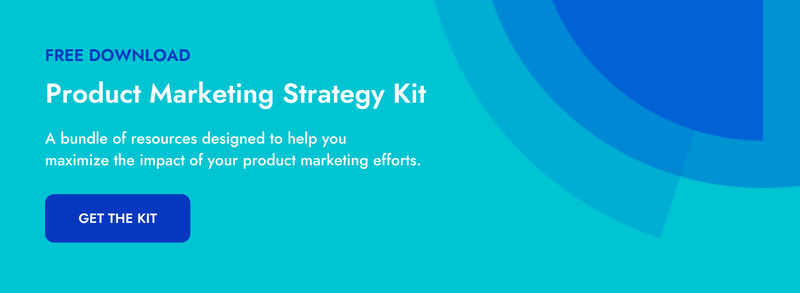As your market saturates, connecting with your target audience becomes increasingly difficult. With each new competitor that pops up, you have to work that much harder to say something unique—something that differentiates your company's product from its alternatives.
This is true no matter what promotional channel you're using. Whether you're writing an email, revising your website copy, or creating a customer case study, ask yourself: "In the eyes of a prospect, is this unique, memorable, and compelling, or is this just more noise?"
Elevate your product marketing strategy with this free kit >>
It's especially important to ask yourself this question when you're advertising your product on a platform like Google or Facebook. Why? Well, for some perspective, it's projected that 56% of ads in 2021 will be digital, and the total global spending on online ads is forecasted to reach $389 billion this year. In other words, to be competitive, you must take advantage of online product advertising.
It’s clear that companies understand the value of this marketing channel, and its widespread use puts pressure on advertisers to make sure their ads stand out from the crowd. Speaking from personal experience, there are times when I'll skip right over a product ad entirely, frustrated that it's clogging up my feed. While I’m sure you can relate, there are also plenty that do catch my eye, and I find myself fixated on them. These show-stopping ads tend to be well-crafted and designed, informative, to the point, and have a unique and/or clever component to them.
Today, we’ll walk through 16 excellent B2B and B2C online product advertising examples put forth by brands within competitive industries. We will explore what makes them stand out and why we believe they are effective. Not only are the examples eye-catching, but each one has managed to differentiate their product from their rivals.
Without further ado, let’s dive in!
Product advertising examples from Google
To start out, let’s take a look at Google advertising. Of all the platforms we’ll explore today, Google has the highest volume of digital advertisers, over 4 million.
1. Pollfish
In our first example, Pollfish illustrates the power of explicitly emphasizing the benefits of a solution. No one buys a survey tool because of its sleek interface or customizable analytics toolkit; someone buys a survey tool because it will enable them to make better decisions. By boldly incorporating this language into their headline, Pollfish sends a cogent message to their prospects: “We know what you’re trying to accomplish, and we’re here to help.” In other words, it’s to the point.
2. Pimsleur
Now that is how you break through the noise and say something unique—something that prospects will be hard-pressed to forget. Being fluent is cool, but do you know what’s really cool? Speaking like you were born there. This Pimsleur ad, much like our previous example, is a reminder to product marketers everywhere: Stay focused on what your target audience is ultimately trying to achieve.
3. Outplay
If there’s one industry where it’s all too easy to lose sight of what the target audience is ultimately trying to achieve, it’s the sales engagement industry.
Why? Because, when it comes to email outreach, sales reps have so many ancillary goals. They’re trying to get more opens. More responses. More meetings. But none of that matters if they don’t close more deals. By going beyond the vanity metrics, Outplay makes it clear that they’re fully committed to helping sales professionals succeed.
4. Bright
Let’s be honest: If you’re in a crowded market, the rival product marketers with whom you’re competing probably know a thing or two about emphasizing benefits and speaking to prospects’ goals. So, how can you go one step further and make a lasting impression? One word: data.
Any old personal finance app can help you pay off your credit card debt—but how many can help you pay off your credit card debt eight times faster? With the inclusion of one single digit, Bright turns a good ad into a great ad. Ask yourself: How might your company quantify the impact that your product makes on the lives of its users?
Product advertising examples from LinkedIn
Next, we’ll look at LinkedIn, one of the most popular social media platforms used for business professionals. For B2B companies, in particular, this platform is an advertising goldmine. In fact, over 663.3 million people can be targeted with LinkedIn ads.
5. Outreach
At first glance, you might think we’ve included this Outreach ad because, like our previous example, it quantifies the impact of their product. Although we certainly commend them for that—bonus points for including a specific dollar amount—there’s a different component of this ad that grabbed our attention.
The term curiosity gap refers to the psychological effect that’s created when someone is aware that new and valuable information is within their grasp. In this case, Outreach has made us aware that we can increase sales without increasing headcount—and we want to know how.
6. CHEQ
Curiosity is a powerful feeling—and fear is an even stronger one. And when you’re buying digital ads through a pay-per-click system, the idea of burning the budget on bots is downright scary.
One of the most important parts of being a product marketer is understanding what motivates your prospects. Up until this point, we’ve primarily focused on one type of motivator: goals. But your prospects aren’t exclusively motivated by what they’re trying to achieve; they’re also motivated by what they’re trying to avoid. CHEQ taps into this flawlessly.
7. Cybereason
Wait a minute—didn’t we just make the case for tapping into prospects’ fears? Why are we celebrating an ad that explicitly encourages prospects to not be afraid?
Because this example from Cybereason does something special: It makes the prospect the hero of their own story. It suggests that the work of the security professional has some kind of higher purpose. When you buy Cybereason, you’re not just combating ransomware—you’re defending your colleagues from people who wish to do them harm.
8. Hootsuite
Infomercials that kick off with a spokesperson saying “Has this ever happened to you?” are obviously very silly, but they tap into something real: When we come across a story to which we can relate, we’re more inclined to listen. With this ad, Hootsuite manages to capture the desired effect of an infomercial—without all the silliness. They know it wasn’t just Clarins that had to shift their social strategy in response to COVID-19. By including that customer quote, Hootsuite is able to strike a chord with prospects in similar situations.
Product advertising examples from Instagram
Now, let’s take a look at some product advertisements from Instagram—the platform with a potential reach of 928.5 million. With a reach that high, it’s almost guaranteed that your target audience utilizes it in some capacity.
9. Bumped App
Two things immediately stand out in this ad: The headline and the Starbucks cup. Bumped’s choosing of Starbucks to highlight was strategic—a brand that appeals to the masses and coffee being an expense that consumers spend money on every day.
The headline would pique any Starbucks aficionados’ interest, asking themselves: “What do you mean I can own the store, too?” It leaves readers with a feeling of curiosity and excitement about the possibility of becoming an “owner”... for free!
10. Walmart
I think we can all agree that Kleenex products are, well ... relatively straightforward and advertising for them takes some serious out-of-the-box thinking. Walmart and Kleenex demonstrated versatility for these tissue boxes, leaning on the idea of its multi-use capabilities—especially for those going back to school.
Who would have thought that you could customize a tissue box and that it could be used to declutter? Now, that’s a surefire way to differentiate your seemingly “basic” product and appeal to audiences on a new level—all while remaining timely in messaging!
11. Zendesk
A complete 360 from our previous example, sometimes simplicity is key!
Zendesk kept their ad minimalistic, including one headline and screenshot examples of their chat feature and customer support integration capabilities. While that pretty much covers the graphic itself, the caption is strong—short, to the point sentences with an impressive statistic at the end to add credibility to their claims.
Their point is clear: If you want happier customers, you need our product.
12. Brandfolder
Reorganizing digital files can feel like a daunting task—one that gets pushed farther and farther down the to-do list. Admittedly, there’s been plenty of times when I’ve searched for a photo or file on my desktop, and it takes much longer than it should.
Similar to Zendesk’s minimalistic approach, Brandfolder kept text limited. Their ad is powerful and visual-focused, hitting on a common pain point, lack of organization. The before and after visual says it all—this is what your desktop could like with the help of our product. It subconsciously highlights the great organizational benefits of their digital asset management platform and makes you rethink how you’ve been managing your assets.
Product advertising examples from Facebook
Facebook is a top platform in the digital advertising space with over 2 million advertisers utilizing it. Historically a B2C-driven platform, B2B companies have broken into the space, seeing great results and ROI.
13. Barkbox
If you’re an animal person, chances are you know how crowded the pet industry is. When you’ve got big names to compete against like Petco, PetSmart, and Pet Supplies Plus, it’s easy to get overshadowed.
BarkBox recently pushed out a product ad campaign around their latest product series—Highway to Howl! Clever in its wording, the ad is comical, unique, and plugs some free additional toys. The toy spotlighted perfectly aligns with the theme, and there’s no doubt that its quirky-in-nature approach can easily catch the eye of pet owners.
And after all, what “hairy” pup wouldn’t howl at that?
14. Doordash
Consumers want processes streamlined—whether that be a virtual doctor’s appointment versus in person or in our case, ordering food. There’s no doubt that food apps have taken over the restaurant industry, acting as a middle-man between consumers and restaurants.
While some picture DoorDash solely as a delivery app, this ad promotes an overlooked offering, pickup. The company isn’t promoting a colossal new discovery or idea—they’re simply informing consumers that there is a better option available to them at the touch of their fingertips.
Hitting on common pain points, the ad subtly promotes that it’s fee-free, you can order ahead, and skip all lines—what’s better than that when in a time crunch?
15. Salesforce
When it comes to CRM, Salesforce is the cream of the crop. They know what they do best, and they certainly know how to showcase it effectively.
In this example, Salesforce leans heavily on text, promoting its adaptability for a wide range of business sizes. At a glance, you see “ALL business” stand out. But upon a closer look, you can see the play on words—”smALL business.” They’ve successfully appealed to both small and large enterprises in two simple words. The statistic included in the caption is just another bonus to convince readers to sign up for Salesforce. Now, that’s an impressive ad!
16. Emotive
This example from Emotive, a company that enables eCommerce merchants to scale relationships with customers through conversational texting, is similar to the Brandfolder ad we explored. It’s to the point and relies on visuals, highlighting improved conversion rates.
Anyone looking at the ad can see that texts like “the old way” are dull, impersonal, and one-sided. The comparison to Emotive’s “new way” (or conversational texting approach) is a strong representation of the type of relationship-building that can happen if businesses utilize Emotive.
They successfully showcased the value of their product with the side-by-side comparison, and the plug about leading brands seeing an average ROI of 18% certainly can help seal the deal!
Improve your product marketing strategy
We hope these online product advertising examples have been helpful for you as you work to grow and improve your own ads. But, we would be remiss not to mention that there are many other important initiatives to keep in mind when drafting out your product marketing strategy.
With Crayon’s Product Marketing Strategy Kit, you’ll learn everything you need to know about putting together a winning strategy that makes you stand out from your competitors. Whether it’s a product launch checklist or key questions to ask yourself when shaping out your plan, we’ve got you covered!
Download your free kit today!

Seeing is believing! Check out Crayon for yourself.
Take a Product TourRelated Blog Posts
Popular Posts
-
 The 8 Free Market Research Tools and Resources You Need to Know
The 8 Free Market Research Tools and Resources You Need to Know
-
 How to Create a Competitive Matrix (Step-by-Step Guide With Examples + Free Templates)
How to Create a Competitive Matrix (Step-by-Step Guide With Examples + Free Templates)
-
 6 Competitive Advantage Examples From the Real World
6 Competitive Advantage Examples From the Real World
-
 24 Questions to Consider for Your Next SWOT Analysis
24 Questions to Consider for Your Next SWOT Analysis
-
 How to Measure Product Launch Success: 12 KPIs You Should Be Tracking
How to Measure Product Launch Success: 12 KPIs You Should Be Tracking



